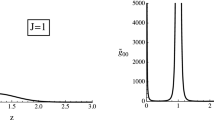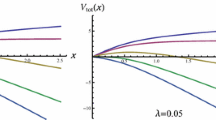Abstract
It is well known that the potential energy of two heavy quarks carries an important information about the physics of confinement. Using the Wilson loop confinement criterion and the Nambu–Goto string action, this energy can be derived within the bottom-up holographic approach to strong interactions. We recapitulate the standard holographic derivation of the potential between two static sources with emphasis on the physical interpretation of the results. We address the problem of regularization of the arising ultraviolet divergence in the general case, with “ultraviolet” referring to small values of the holographic coordinate associated with the inverse energy scale in holographic duality. We show that in the case of the widely used soft-wall holographic models many ultraviolet divergences can appear in principle, although the appearance of more than two different divergences looks somewhat exotic in practice. Some possible subtraction schemes are discussed. Different schemes lead to a different constant shift of the potential energy, which entails a certain scheme dependence of holographic predictions for the constant term in the resulting Cornell-like confinement potentials.

Similar content being viewed by others
Notes
See, however, [8] and the references therein, where it was advocated that the structure of holographic theories for QCD should arise within the framework of some noncritical string theory in which the condensation of a scalar tachyon can naturally generate the SW model background; actually, this hypothesis was already suggested in the pioneering paper [4].
In [13], the term “quark” actually meant an infinitely massive vector boson connecting the \(N\) branes with one brane that was far away in the \(y\) direction. Only in this case is the subtraction of mass well motivated because it appears in the Wilson loop. We prefer to use the term “heavy source,” implicitly meaning “heavy quark.”
References
J. M. Maldacena, “The large \(N\) limit of superconformal field theories and supergravity ,” Adv. Theor. Math. Phys., 2, 231–252 (1998); Internat. J. Theor. Phys., 38, 1113–1133 (1999); arXiv: hep-th/9711200.
E. Witten, “Anti-de Sitter space, thermal phase transition, and confinement in gauge theories,” Adv. Theor. Math. Phys., 2, 505–532 (1998); arXiv: hep-th/9803131.
S. S. Gubser, I. R. Klebanov, and A. M. Polyakov, “Gauge theory correlators from non-critical string theory,” Phys. Lett. B, 428, 105–114 (1998); arXiv: hep-th/9802109.
A. Karch, E. Katz, D. T. Son, and M. A. Stephanov, “Linear confinement and AdS/QCD,” Phys. Rev. D, 74, 015005, 7 pp. (2006); arXiv: hep-ph/0602229.
O. Andreev, “\(1/q^2\) corrections and gauge/string duality,” Phys. Rev. D, 73, 107901, 4 pp. (2006); arXiv: 0603170.
S. S. Afonin and T. D. Solomko, “Towards a theory of bottom-up holographic models for linear Regge trajectories of light mesons,” Eur. Phys. J. C, 82, 195, 36 pp. (2022); arXiv: 2106.01846.
I. R. Klebanov and J. M. Maldacena, “Solving quantum field theories via curved spacetimes,” Phys. Today, 62, 28–33 (2009).
I. Iatrakis, E. Kiritsis, and A. Paredes, “An AdS/QCD model from tachyon condensation: II,” JHEP, 11, 123, 54 pp. (2010); arXiv: 1010.1364.
S. S. Afonin, “Holographic-like models as a five-dimensional rewriting of large-\(N_\mathrm{c}\) QCD,” Internat. J. Modern Phys. A, 25, 5683–5710 (2010); arXiv: 1001.3105.
O. Andreev and V. I. Zakharov, “Heavy-quark potentials and AdS/QCD,” Phys. Rev. D, 74, 025023, 6 pp. (2006); arXiv: hep-ph/0604204.
G. S. Bali, “QCD forces and heavy quark bound states,” Phys. Rep., 343, 1–136 (2001); arXiv: hep-ph/0001312.
H. Boschi-Filho, N. R. F. Braga, and C. N. Ferreira, “Static strings in Randall–Sundrum scenarios and the quark anti-quark potential,” Phys. Rev. D, 73, 106006, 5 pp. (2006); Erratum 74, 089903, 1 pp. (2006), arXiv: hep-th/0512295; C. D. White, “The Cornell potential from general geometries in AdS/QCD,” Phys. Lett. B, 652, 79–85 (2007), arXiv: hep-ph/0701157; D.-F. Zeng, “Heavy quark potentials in some renormalization group revised AdS/QCD models,” Phys. Rev. D, 78, 126006, 9 pp. (2008), arXiv: 0805.2733; H. J. Pirner and B. Galow, “Strong equivalence of the AdS-metric and the QCD running coupling,” Phys. Lett. B, 679, 51–55 (2009), arXiv: 0903.2701; F. Jugeau, “Hadrons potentials within the gauge/string correspondence,” Ann. Phys., 325, 1739–1789 (2010), arXiv: 0812.4903; S. He, M. Huang, and Q.-S. Yan, “Logarithmic correction in the deformed AdS\(_5\) model to produce the heavy quark potential and QCD beta function,” Phys. Rev. D, 83, 045034, 14 pp. (2011), arXiv: 1004.1880; R. C. L. Bruni, E. Folco Capossoli, and H. Boschi-Filho, “Quark-antiquark potential from a deformed AdS/QCD,” Adv. High Energy Phys., 2019, 1901659, 6 pp. (2019), arXiv: 1806.05720; K. Hashimoto, K. Ohashi, T. Sumimoto, “Deriving the dilaton potential in improved holographic QCD from the meson spectrum,” Phys. Rev. D, 105, 106008, 7 pp. (2022), arXiv: 2108.08091.
J. M. Maldacena, “Wilson loops in large \(N\) field theories,” Phys. Rev. Lett., 80, 4859–4862 (1998); arXiv: hep-th/9803002.
N. Drukker, D. J. Gross, and H. Ooguri, “Wilson loops and minimal surfaces,” Phys. Rev. D, 60, 125006, 20 pp. (1999); arXiv: hep-th/9904191.
A. Brandhuber, N. Itzhaki, J. Sonnenschein, and S. Yankielowicz, “Wilson loops in the large \(N\) limit at finite temperature,” Phys. Lett. B, 434, 36–40 (1998); arXiv: hep-th/9803137.
Y. Kinar, E. Schreiber, and J. Sonnenschein, “\(Q\bar Q\) potential from strings in curved space-time — classical results,” Nucl. Phys. B, 566, 103–125 (2000); arXiv: hep-th/9811192.
S. S. Afonin and T. D. Solomko, “Gluon string breaking and meson spectrum in the holographic Soft Wall model,” Phys. Lett. B, 831, 137185, 9 pp. (2022); arXiv: 2112.00021.
S. S. Afonin and T. D. Solomko, “Cornell potential in generalized soft wall holographic model,” J. Phys. G, 49, 105003 (2022); arXiv: 2208.02604.
I. Ya. Aref’eva, “Holography for heavy ions collisions at LHC and NICA,” EPJ Web Conf., 164, 01014, 20 pp. (2017); arXiv: 1612.08928.
S. J. Brodsky, G. F. de Téramond, H. G. Dosch, and J. Erlich, “Light-front holographic QCD and emerging confinement,” Phys. Rept., 584, 1–105 (2015); arXiv: 1407.8131.
S. S. Afonin and T. D. Solomko, “Confinement potential in a soft-wall holographic model with a hydrogen-like spectrum,” Universe, 9, 114, 14 pp. (2023); arXiv: 2303.02356.
S. S. Afonin and T. D. Solomko, “Confinement potential in Soft Wall holographic approach to QCD,” arXiv: 2209.07109.
Funding
This research was funded by the Russian Science Foundation (grant No. 21-12-00020).
Author information
Authors and Affiliations
Corresponding author
Ethics declarations
The author declares no conflicts of interest.
Additional information
Translated from Teoreticheskaya i Matematicheskaya Fizika, 2023, Vol. 216, pp. 433–444 https://doi.org/10.4213/tmf10467.
Rights and permissions
About this article
Cite this article
Afonin, S.S. Ultraviolet regularization of energy of two static sources in the bottom-up holographic approach to strong interactions. Theor Math Phys 216, 1278–1286 (2023). https://doi.org/10.1134/S0040577923090039
Received:
Revised:
Accepted:
Published:
Issue Date:
DOI: https://doi.org/10.1134/S0040577923090039




